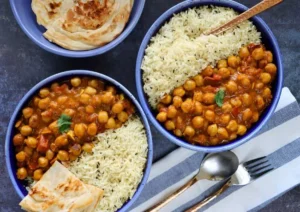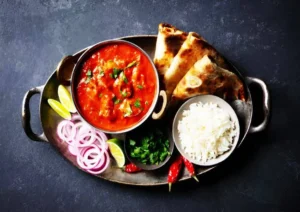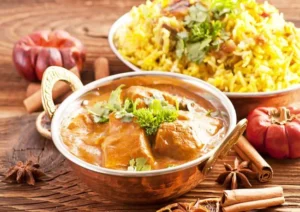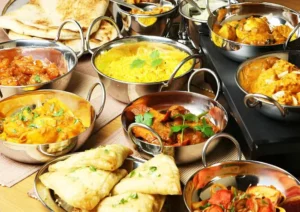A Look at Indian Food Nutrition
Getting to Know Indian Cuisine
Indian food is a vibrant blend of different flavors, aromas, and textures.
Each part of the country has its own special cooking style shaped by its landscape and culture.
The spices used in these dishes not only make them taste amazing but also come with a bunch of health perks.
Personally, I love how a spicy curry can really hit the spot and nourish the body at the same time.
Nutritional Stuff in Indian Food
Indian food has a super diverse nutritional profile that usually includes:
- Carbs: These come from grains such as rice and wheat.
- Proteins: You’ll find these in lentils, legumes, and dairy.
- Fats: These come from oils and ghee, which provide essential fatty acids.
- Vitamins and Minerals: They are plentiful in veggies and spices, providing great health benefits.
Knowing these components can help you create a balanced and nutritious Indian diet.
Common Ingredients and What They Bring to the Table
Lentils and Legumes
Lentils and legumes are big players in Indian meals. They’re loaded with protein and fiber.
They not only fill you up but also provide a warm base for many dishes. I can’t resist a cozy bowl of dal when I’m busy!
Spices and Herbs
Spices and herbs are like the soul of Indian cooking, bringing flavor and health benefits. Here’s a couple of examples:
- Turmeric: Known for its anti-inflammatory properties.
- Cumin: Good for digestion and has lots of iron.
Veggies and Fruits
The colorful mix of veggies and fruits is what makes Indian food exciting. They are rich in vitamins and antioxidants,
used often in curries and salads. Each ingredient, from bitter gourd to sweet mango, brings its own health kick.
Grains and Cereals

Grains and cereals form the backbone of Indian meals, giving you energy.
Common options like rice and whole wheat chapati keep you satisfied throughout the day.
If you have a diet that includes these choices, you’re in for a hearty, healthy treat!
Traditional Indian Dishes and Their Nutritional Values
Dal (Lentil Curry)
Dal is a staple dish in India, offering a rich source of protein and fiber.
Seasoned with spices, it warms you up and gives you the nutrients you need for everyday life.
It’s a comfort food I love on chilly nights!
Chana Masala (Chickpea Curry)
Chana Masala is another great dish that’s full of protein and fiber thanks to chickpeas.
This tasty curry, packed with spices, not only delights your taste buds but also helps with digestion.
It pairs perfectly with rice or flatbread for a filling meal.
Saag Paneer (Spinach with Cheese)
Saag Paneer brings together the goodness of spinach and cheese. It’s rich in iron and calcium.
This dish shows how Indian food beautifully balances flavor and nutrition, often reminding me of lovely family dinners.
Tandoori Chicken
Tandoori Chicken gets its flavor from a yogurt and spice marinade and is packed with protein.
Grilled just right, it’s a healthier choice compared to fried meats but still tastes amazing.
This dish often features in celebrations, showcasing Indian hospitality.
Health Perks of Indian Food
Loaded with Nutrients
A huge plus about Indian food is its rich nutrition. Packed with a variety of ingredients like lentils and veggies, it offers:
- Vitamins: Key for keeping you healthy.
- Minerals: Vital for your body to function well.
Helping to Prevent Diseases
Indian dishes often have spices like turmeric and ginger that are known for their anti-inflammatory benefits.
These ingredients can help you with:
- Boosting immunity: Helps keep you healthy.
- Heart health: Some spices might help lower cholesterol.
Weight Management Benefits

Many Indian dishes are rich in fiber, aiding digestion and keeping you full.
Meals focused on whole foods like legumes and veggies can help you manage your weight without missing out on flavor.
From what I’ve experienced, choosing wholesome options like veggie curries promotes healthy eating habits.
Possible Downsides or Challenges
Some dishes can be high in calories and fat.
While Indian food is loved for its bold flavors, some traditional dishes can rack up high calories and fat content.
For instance, rich curries and fried snacks show up at family gatherings, which can leave you feeling a bit guilty after indulging.
So it’s good to enjoy these dishes in moderation!
Too Much Oil and Ghee
A lot of recipes call for generous pours of oil or ghee, which can lead to higher calorie counts.
I’ve noticed that sometimes meals made with too much ghee leave me feeling heavy afterward.
It’s all about finding the right balance with these ingredients to support your health.
Sugar in Desserts
Indian sweets can be super delicious but usually pack a sugar punch.
Treats like gulab jamun and jalebi are irresistible, especially during festive times. To really enjoy these goodies without going overboard,
it’s smart to keep portions in check and savor them occasionally.
Striking a balance between indulgence and healthy choices can really make a difference!
Tips for Creating a Balanced Indian Diet
Watch Your Portions
If you want to enjoy Indian food while keeping things balanced, portion control is super important.
A personal trick I like is using smaller plates. It can help trick your brain into feeling satisfied with less food while promoting mindful eating
and allowing you to enjoy all those amazing flavors.
Healthier Cooking Methods
Using healthier cooking techniques can really boost the nutrition of traditional dishes. Think about:
- Steaming instead of frying veggies.
- Baking marinated meats like tandoori chicken instead of deep-frying.
- This cuts down on calories while keeping essential nutrients intact.
Mixing it Up

Having a variety in your meals is key. Combining different veggies, lentils, and grains can create well-balanced plates. For example,
teaming a lentil dish with a bright vegetable stir-fry ensures you’re getting a wide range of nutrients.
Plus, embracing variety makes meals way more interesting!
Sample Indian Food Nutrition Plan
Balanced daily Meal Idea
Creating a balanced meal plan is super important for your nutrition. Here’s a simple idea for a day’s meals:
- Breakfast: Idli with coconut chutney and sambar.
- Lunch: Brown rice with dal, mixed veggie curry, and raita.
- Dinner: Tandoori chicken with whole wheat roti and a salad.
For me, this combination keeps meals tasty and nutritious all day long!
Caloric Breakdown
Understanding how calories are distributed helps keep your energy in check. A good mix might look like:
- 50% Carbs: From rice, roti, and legumes.
- 30% Proteins: Coming from lentils, chicken, and dairy.
- 20% Fats: Coming from cooking oils and nuts.
By keeping these proportions in mind, you can enjoy traditional Indian food and maintain a healthy nutritional balance!
Wrapping Up
Recap on Indian Food Nutrition
From what we’ve seen in Indian cuisine, it’s obvious that this vibrant food culture is packed with essential nutrients.
With its mix of lentils, veggies, and spices, you get loads of health benefits.
Focusing on fresh ingredients and balanced meals can really nourish you and please your taste buds.
Encouraging a Healthy Diet
For anyone wanting to keep a healthy lifestyle,
dive into the diverse world of Indian food. Try adding:
- Whole grains: like brown rice and whole wheat flatbread.
- Fresh veggies: for key vitamins and minerals.
Enjoy these delicious meals in moderation and keep trying new flavors. Health and enjoyment can go hand in hand!
HOSTINGER HOSTING PLAN DISCOUNT CODE

Your article helped me a lot, is there any more related content? Thanks!